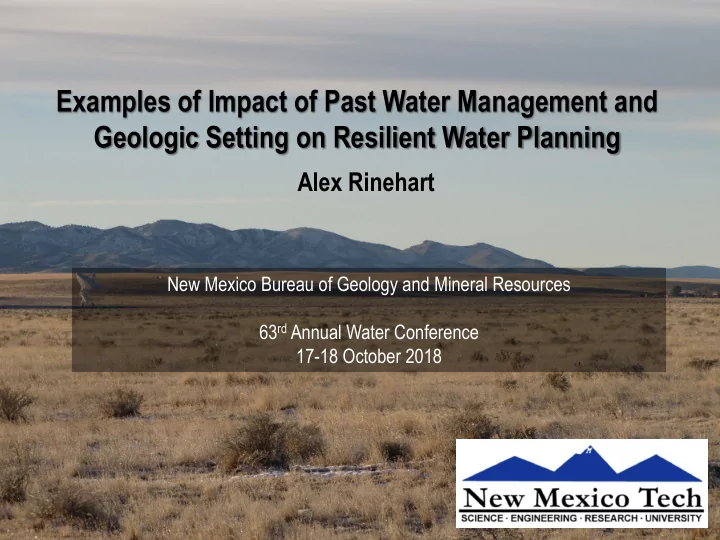

Examples of Impact of Past Water Management and Geologic Setting on Resilient Water Planning Alex Rinehart New Mexico Bureau of Geology and Mineral Resources 63 rd Annual Water Conference 17-18 October 2018 New Mexico Bureau of Geology and Mineral Resources
Future water supply governed by geology and past water management. This talk shows three examples of groundwater management impacted by both regulation and climate change. • Southern High Plains • Albuquerque Basin • Pecos Valley Artesian District New Mexico Bureau of Geology and Mineral Resources
USGS/OSE Groundwater Level Measurements in NM Coverage of water level measurement has gotten smaller Fewer measurements have been collected in recent decades New Mexico Bureau of Geology and Mineral Resources
USGS/OSE Groundwater Level Measurements in NM Coverage of water level measurement has gotten smaller Fewer measurements have been collected in Consistent data is required. recent decades New Mexico Bureau of Geology and Mineral Resources
Southern High Plains NMBGMR Open-file Report 591 Rawling and Rinehart Geology High yield aquifer—Ogallala Formation. Effectively no natural recharge, no perennial streams. Previous water management High volume agricultural pumping (95% or more of water use). High percentage of land is arable. Primary economy is agriculture, both dairies and crops. New Mexico Bureau of Geology and Mineral Resources
The Result At current decline rates, region has less than 5 years. Paleochannels have less than 25 years. The Plan for the Cities Conserve now. Get new wells in paleochannels. Lobby for $500 million diversion from Ute Reservoir on Canadian River. Agriculture? New Mexico Bureau of Geology and Mineral Resources
The Result At current decline rates, region has less than 5 years. Paleochannels have less than 25 years. The Plan for the Cities Conserve now. Get new wells in paleochannels. Lobby for $500 million diversion This analysis relied on from Ute Reservoir on Canadian historical data. Future River. planning relies on it, Agriculture? too. New Mexico Bureau of Geology and Mineral Resources
Albuquerque Basin NMWRRI Completion Report, part of Statewide Water Assessment. Rinehart and Mamer. Past water management Until mid-2000s, drinking water largely Geology came from groundwater for NM’s Basin-fill aquifer, with wells largest city. completed in ancestral Rio Before mid-1990s, though of “Lake Grande deposits. Michigan” volume of freshwater. Aquifer is connected to Rio Hawley and others corrected this in Grande in valley. mid-1990s—GOOD GEOLOGY Recharge from river, some Brought San Juan surface water rights online, began active use and recharge mountain block and focused 2008/2009. recharge along flanks. New Mexico Bureau of Geology and Mineral Resources
The Result Large (>250 ft) declines through 2000s, followed by slight (~10%) rebound because of San Juan- Chama Diversion. The Future? Rio Grande and Colorado River flows likely to become less consistent year-to-year, contentious. Water Authority is looking forward 100 years. Resilient use needs groundwater storage and recharge. New Mexico Bureau of Geology and Mineral Resources
The Result Large (>250 ft) declines through 2000s, followed by slight (~10%) rebound because of San Juan- Chama Diversion. The Future? This effort relied on Rio Grande and Colorado River flows likely to become less historical data and consistent year-to-year, contentious. reliable geologic Water Authority is looking forward mapping. Future 100 years. planning relies on it, Resilient use needs groundwater storage and recharge. too. New Mexico Bureau of Geology and Mineral Resources
Pecos Slope and Pecos Valley Artesian District NMWRRI Completion Report, part of Statewide Water Assessment. Mamer and Rinehart. Past water management Wells drilled in confined aquifer in early 1900s. Drainage issues, river drying led to Geology conjunctive use regulation in 1930s. Confined aquifer recharged in High volumes of pumping from 1950s to Sacramento Mountains. 1960s. Local monitoring begins! Alluvial aquifer recharge by River dried up. Basin adjudicated in Pecos River. 1960s to 1970s. Seals put in place in wells between alluvial and confined Pecos River has compact on aquifer. Active PVACD management it, snowmelt dominated flow. begins. New Mexico Bureau of Geology and Mineral Resources
Pecos Slope and Pecos Valley Artesian District What happened? Water levels have stabilized while compact requirements have been met. Active management included retiring water rights, negotiation with other compact members. Water use is monitored and enforced with stiff penalties involving loss of future water access. Active monitoring of aquifer allows switching between confined and alluvial aquifer to manage river flows, agricultural needs. The future? Active management, local engagement and flexible hydrogeology allow resilient management. Snow pack will dwindle—what will the effect be on mountain block recharge? River flows will be less consistent. New Mexico Bureau of Geology and Mineral Resources
Pecos Slope and Pecos Valley Artesian District What happened? Water levels have stabilized while compact requirements have been met. Active management included retiring water rights, negotiation with other compact members. Water use is monitored and enforced with stiff penalties involving loss of future water access. Active monitoring of aquifer allows switching between confined and alluvial Active management requires data. Analysis aquifer to manage river flows, agricultural needs. required data. The future? Active management, local engagement and flexible hydrogeology allow resilient management. Snow pack will dwindle—what will the effect be on mountain block recharge? River flows will be less consistent. New Mexico Bureau of Geology and Mineral Resources
Take-Homes Future water management resilience depends on local geology and past water management decisions. • Management works, especially with groundwater recharge and with legal and practical recognition of physical hydrology. • Management needs data—and our statewide network needs to be maintained and made more efficient. • The ‘bank’ of groundwater can run dry with poor (or no) management. Funding from the state of New Mexico through a grant to the New Mexico Water Resources Research Institute’s Statewide Water Assessment, and by the City of Clovis. Data from the USGS. New Mexico Bureau of Geology and Mineral Resources
Recommend
More recommend